 The English translation follows
The English translation followsLa modă
De stil eclectic, cu ornamente de sorginte neogotică şi cu accente neoclasice, arhitectura casei era la modă în Bucureşti, în anul construirii ei.
Stilul naţional, neoromânesc, avea să se închege abia peste vreo trei decenii, iar împrumuturile din stilurile vest-europene, chiar revolute, erau la ordinea zilei.
Clădirea păstrează decorul faţadei, care îmbină coerent expresivitatea neoclasicului cu aceea a detaliului neogotic, dezvăluind privirii o simbioză armonioasă.
Din păcate, s-au pierdut majoritatea ornamentelor neogotice de la tâmplăria deschiderilor. Numai câteva rezistă la ferestrele etajului 2, pe interiorul cercevelelor.
Mai pot fi văzute rămăşiţe şi la poarta de intrare principală, care închide gangul ce dă acces la una dintre scările clădirii şi la curtea interioară.
Poarta originală a fost înlocuită cu o poartă de scânduri vopsite funebru cu negru.
Balcoanele au balustradele decorative de origine, delicat lucrate în metal. Pe faţada dinspre strada Tonitza, la partea superioară a două deschideri de la parter, se păstrează gratiile ornamentale din secolul XIX.
La parter, într-unul dintre restaurante, au fost dezveliţi frumoşii stâlpi de metal care fac parte din sistemul iniţial de sprijin al clădirii.
Omniprezenta mizerie
În afară de spaţiile comerciale de la parter, igienizate, restul clădirii e într-o stare mizerabilă.
Toaletele casei, evident comune (în afară de cele încuiate cu lacăt)

Incendiu cu repetiţie
Până la primul incendiu, în 31 octombrie, când au fost întrerupte utilităţile pentru o parte din casă. Incendiul a pornit de la etajul I, deasupra restaurantului Bonne bouche.
Ferestrele distruse ale încăperii au fost „reparate” cu nişte cartoane mâzgălite neglijent.
Al doilea incendiu, în 25 noiembrie, intervenit la mansardă, s-a soldat cu un mort şi cu distrugerea aproape totală a acoperişului şi a lucarnelor.
Acum, restaurantele funcţionează, locatarii de la primul şi cel de al doilea etaj stau bine mersi în încăperile insalubre.
Cei de la mansardă, unii dintre ei proprietari, stau sub acoperişul spart, cu căpriorii carbonizaţi.
În interiorul sordid al casei, scara păstrează numai câţiva dintre baluştrii de fier forjat originari.
La etajul I, câteva console aduc aminte de faptul că, la origine, interiorul a fost îngrijit decorat.
Frumosul luminator al scării, în mizerie, are ochiurile de geam sparte şi murdare.
Curtea din spatele clădirii e un teren viran, plin de gunoaie.

La fel cu întregul centru vechi, dacă te uiţi dincolo de strălucirea factice a vitrinelor de restaurant, vezi spectrul mizeriei etajelor rânjind ameninţător… şi zadarnic.
Copyright Silvia Colfescu 2011
To make the post accessible to English speaking readers, our beloved friend Sarah translated it into English. Thank you, dear Sarah!
Fashionable
Eclectic in style, with ornaments of neo-gothic origin and a neo-classic undertone, this form of architecture was fashionable in Bucharest the year the house was built (1872).
All these elements are borrowed from western Europe's styles. The national neo-romanian style was only to become widespread three decades later.
The building keeps the facade's decor which combines the expression of neo-classicism with neo-gothic detail, revealing intertwining harmony.
Unfortunately, the majority of the neo-gothic ornaments around the windows and doors have been lost. One can see what remains of them around the main door which separates the corridor to one of the stairways and the interior courtyard.
The original door was replaced with makeshift black painted wooden planks:
The balconies have retained their original railings, delicately worked in cast iron:
The facade on str Tonitza still has its ornamental window grills dating from the XIXc:
Widespread squallor
With the exception of the spruced-up commercial space on the ground floor, the rest of the building is in a deplorable state. Rather than being restored, the door of the deteriorated main entrance has been lined with sheet metal:
The toilets, clearly communal (except for those padlocked shut):
The hallway on the first floor with a flood-damaged ceiling:
The state of the Miron Vlasto house is identical to that of many other buildings in the old city centre. City Hall, the owner of the house (probably after nationalisation), allotted several spaces to tenants and other individuals who either opened restaurants or sub-let. Several years ago, the administration of the AFI (Administration of Real Estate Inventory) under City Hall who owns many of the buildings situated in the old city centre advised the tenants who were not able to buy that they (AFI) could no longer be responsible for the safety of the building and if they did not want to move, they would be staying at their own risk. Consequently, the tenants stopped paying rent even if they continued to pay their electricity, water and gas bills while others used wood for heating. The house was recently invaded by 'under-priveleged' characters content to live without water, heating and on 'borrowed' electricity.Repeated arson
Part of the utilities were cut following the first fire on 31st October which began on the first floor above the Bonne Bouche restaurant. The windows destroyed by fire were replaced with careless bits of graffiti'd cardboard:
The 2nd fire started in the attic on 25th November. It claimed one victim and destroyed almost the entire roof:
The adjacent restaurants are currently open and the tenants from the first and second floors are still there and bine mersi, in unsalubrious apartments:
Those in the attic, some of them owners, are now living under a broken roof of carbonised beams:
Within the house's sordid interior, the very ricketty staircase has lost almost all its cast iron bannisters but a few are still visible:
On the first floor, a few consoles remind us that, originally, the interior was beautifully decorated:
In a dreadful state, the once-lovely stairwell skylight is broken and filthy:
The back courtyard is a wasteland of trash:
While the front of the building could still impress the eye with its harmony popular 140 years ago, the back, by contrast, suggests only devastation and neglect. Gas pipes and ventilation shafts from the kitchens are installed haphazardly on the walls:
The same is true throughout the old city centre. If you look beyond the beguiling allure of restaurant windows, you will see the grey terror of misery from the above floors... yet again...



























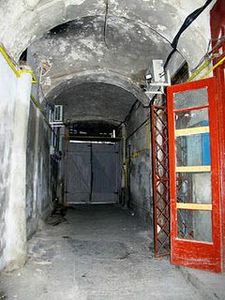
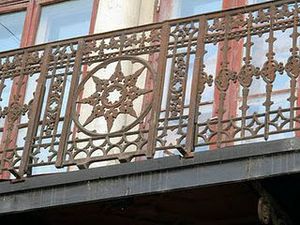
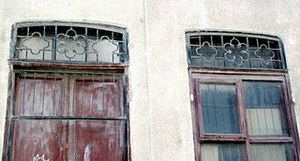
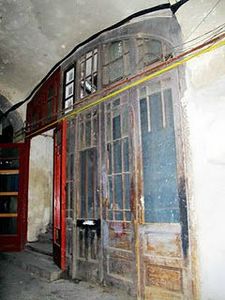
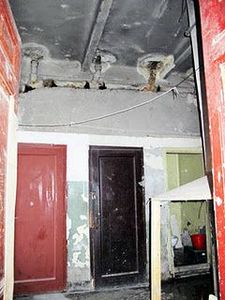
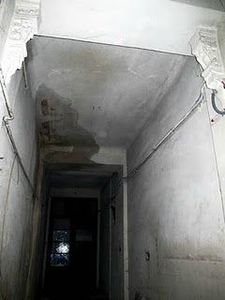
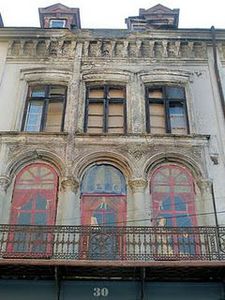
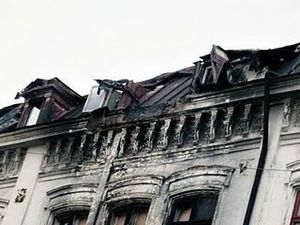





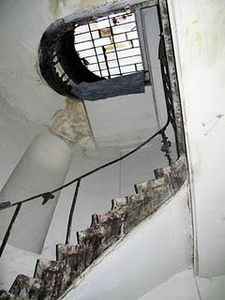

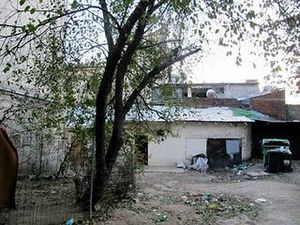
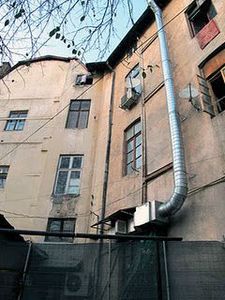

Niciun comentariu:
Trimiteți un comentariu